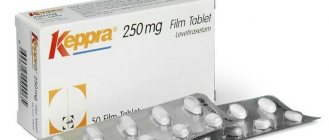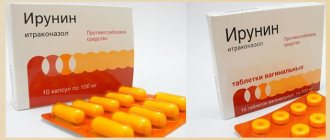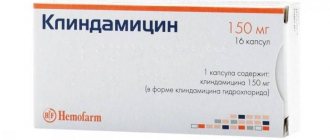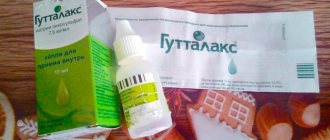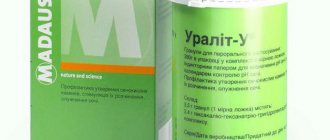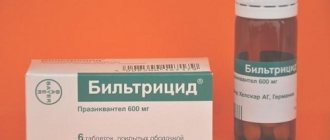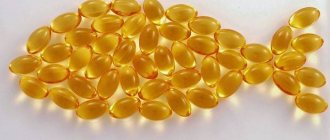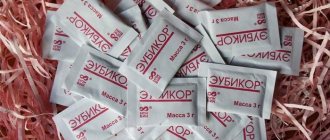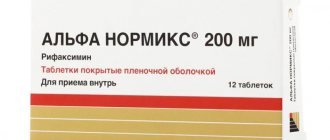Release form and composition
The drug is available in the form of a powder for the preparation of a solution for oral administration: a homogeneous dry mass without foreign particles or agglomerates, white or almost white in color, with the smell of fruit [8 g of powder in three-layer (paper-aluminum-polyethylene) bags, in a cardboard pack of 1 package and instructions for use of Fosfomycin Esparma].
1 package contains:
- active ingredient: Fosfomycin trometamol – 5.631 g, which is equivalent to 3 g of Fosfomycin;
- auxiliary components: sucrose, sodium saccharin, tangerine flavor, orange flavor.
Fosfomycin analogs
There are several analogues of the drug, similar to it either in composition and effect, or with different active components, but with the same therapeutic effect. Popular substitutes are polyvalent bacteriophages and medications:
- Hexamethylenetetramine – antiseptic based on methenamine, release form – solution and tablets;
- Nitroxoline - antibacterial tablets with the active ingredient of the same name;
- Amizolid – similar in principle of action;
- Zyvox is an antibiotic with linezolid;
- Monural - granules for the preparation of solution contain fosfomycin trometamol.
Pharmacological properties
Pharmacodynamics
Fosfomycin Esparma is an antimicrobial drug with a broad spectrum of bactericidal action. Its active substance, fosfomycin, is a structural analogue of phosphoenol pyruvate. The mechanism of its pharmacological action is due to such properties as the ability to penetrate the microbial cell, irreversibly inhibit the enzyme N-acetyl-glucocosamino-3-o-enolpyruvyl transferase and block the condensation of uridine diphosphate-N-acetylglucosamine with phosphoenol pyruvate. As a result of suppression of the synthesis of uridine-5-diphosphate-N-acetylmuramic acid, the initial stage of peptidoglycan formation in the bacterial cell wall is inhibited.
In vitro, fosfomycin trometamol reduces the adhesion of a number of bacteria to the epithelium of the urinary tract. The following microbes show sensitivity to the drug:
- gram-positive microorganisms: Staphylococcus saprophyticus, Enterococcus faecalis;
- gram-negative microorganisms: Escherichia coli, Citrobacter spp. (speciales), Klebsiella pneumoniae, Enterobacter spp., Proteus mirabilis.
Cross-resistance of Fosfomycin Esparma with other antibiotics has not been established. When combined in vitro with cephalexin, amoxicillin, pipemidic acid, a pronounced synergism of antimicrobial action is observed.
Pharmacokinetics
After taking the solution orally, absorption of fosfomycin from the gastrointestinal tract occurs to a moderate extent. The bioavailability of a single dose (3 g) is 32–54%. The maximum concentration (Cmax) in plasma is reached after 2–3 hours and corresponds to approximately 30 mg/l. When eating at the same time, the absorption process slows down.
The substance does not bind to plasma proteins and is not metabolized in the body.
The predominant accumulation of fosfomycin is observed in the urine, where its therapeutic concentration reaches 2–4 g/l 2–4 hours after oral administration at a dose of 3 g; after 6–12 hours it decreases to 1–2 g/l. The average concentration after 36–48 hours is 0.147 g/l.
The minimum inhibitory concentration is 0.128 g/l, it is bactericidal for most common pathogens of urinary tract infections and remains in the urine for at least 48 hours.
The half-life (T1/2) from blood plasma is 3–4 hours.
It is excreted unchanged mainly through the kidneys, and to a small extent through the intestines.
If renal function is impaired, T1/2 of fosfomycin is prolonged depending on the degree of decrease in renal function.
Antibiotic Fosfomycin
According to the medical classification, Fosfomycin is an antibacterial agent for systemic use. This means that the medicine is used orally, parenterally in the form of a solution. The active substance of the composition is fosfomycin sodium, which is capable of destroying pathogenic microorganisms, relieving a person of signs of disease.
Composition and release form
Fosfomycin has a single release form - powder, which can be used in different ways. Its composition and description:
| Description | White crystalline powder for solution for injection or self-use |
| Fosfomycin sodium concentration, g per vial | 1 or 2 |
| Compound | Fosfomycin trometamol |
| Package | Box of 10 bottles |
Pharmacodynamics and pharmacokinetics
Fosfomycin is an antibiotic whose principle of action is associated with the suppression of the first stage of peptidoglycan synthesis in the cell wall of a microorganism. The active substance is a structural analogue of phosphoenol pyruvate, interacts with the enzyme acetylglucosamine enolpyruvate transferase and specifically selectively inhibits it in an irreversible manner.
The drug shows activity against gram-negative and gram-positive bacteria (pseudomonas, Escherichia coli, Proteus, Klebsiella, staphylococci, enterococci, streptococci). Fosfomycin sodium has 60% absorption and is bound to plasma proteins by 10%. 90% of the dose is excreted by the kidneys in the urine. The elimination period is 3-4 hours. The component is not metabolizable and penetrates well into body tissues and fluids.
Indications for use
The instructions for use indicate the indications for use of the drug. These factors include:
- treatment of infectious and inflammatory diseases of the lower urinary tract;
- acute bacterial cystitis, exacerbation of its chronic course;
- acute bacterial urovesical syndrome;
- bacterial nonspecific urethritis;
- asymptomatic massive bacteriuria;
- urinary tract infections after surgery;
- prevention of infection of the urinary system during transurethral diagnostic examination methods and surgical interventions;
- septicemia, bronchiolitis, chronic and acute pneumonia;
- peritonitis, pyothorax, bronchiectasis;
- pyelonephritis, adnexitis, purulent pleurisy with viscous sputum;
- bartholinitis, parametritis, abscess due to pneumonia.
Indications for use
The use of Fosfomycin Esparma is indicated for the treatment of the following bacterial urinary tract infections of various locations caused by antibiotic-sensitive microorganisms:
- acute uncomplicated urinary tract infections;
- asymptomatic bacteriuria.
In addition, the drug is prescribed for the prevention of urinary tract infections caused by transurethral diagnostic studies or surgical interventions.
Fosfomycin sodium
Active substance:
Fosfomycin*
Pharmgroup:
Other antibiotics
Average price in pharmacies
| Name | Manufacturer | average price |
| Fosfomycin esparma 3.0 n1 pack for oral administration | ESPARMA GMBH | 346.00 |
Analogs for the active substance:Monural Urophosphabol Fosfomycin Fosfomycin trometamol |
Contraindications
Absolute:
- severe renal failure with creatinine clearance (CC) less than 20 ml/min;
- sucrase or isomaltase deficiency, glucose-galactose malabsorption syndrome, fructose intolerance;
- the patient's body weight is less than 50 kg;
- breast-feeding;
- age under 12 years;
- hypersensitivity to the components of the drug.
Fosfomycin Esparma should be used with caution in diabetes mellitus and during pregnancy.
Fosfomycin during pregnancy
During pregnancy and breastfeeding, it is not recommended to use Fosfomycin, since it penetrates the placental barrier and is found in breast milk. During lactation (breastfeeding), the use of the powder is permitted only when absolutely necessary and under the strict supervision of the nursing mother and the newborn by the attending doctor.
- Minced meat for cutlets: recipes with photos
- Cyst on the ovary: treatment and symptoms
- Sarcoma - what is this disease and how to treat it
Fosfomycin Esparma, instructions for use: method and dosage
A solution prepared from Fosfomycin Esparma powder is taken orally, on an empty stomach, 2-3 hours before or after a meal, preferably before bedtime.
Before taking the drug, you must empty your bladder.
To prepare the solution, the contents of one packet should be dissolved in 150–200 ml of water and drunk immediately.
Recommended dosage of Fosfomycin Esparma:
- treatment of urinary tract infections: once - 1 sachet (3 g), course of treatment - 1 day;
- prevention of urinary tract infections: once 3 g 3 hours before surgery or transurethral diagnostic studies. Then, 24 hours after the end of the operation or study, the patient should re-take the drug at a dose of 3 g.
Price
You can buy the drug through online platforms or pharmacy kiosks at prices that depend on the concentration of the active substance and trade markups. Approximate cost of the medication and its analogues:
| Name | Internet price tag, in rubles | Pharmacy price, in rubles |
| Fosfomycin powder 1 g 20 ml | 397 | 410 |
| Hexamethylenetramine 1 ampoule | 55 | 60 |
| Nitroxoline tablets 500 mg 50 pcs. | 91 | 99 |
| Monural powder packet 2 g | 387 | 399 |
Side effects
- from the nervous system: often – dizziness, asthenia, headache; sometimes – paresthesia, a feeling of numbness of the skin and/or crawling; frequency not established – optic neuritis;
- from the blood and lymphatic system: sometimes – leukopenia, thrombocytosis;
- from the cardiovascular system: rarely – tachycardia; frequency not established – decrease in blood pressure (BP);
- from the immune system: frequency has not been established - hypersensitivity reactions (skin rash, urticaria, angioedema), itching, anaphylactic shock;
- from the respiratory system, chest organs and mediastinum: frequency not established - bronchial asthma;
- from the liver and biliary tract: sometimes - increased activity of liver transaminases;
- from the gastrointestinal tract: sometimes – nausea, diarrhea, dyspepsia; rarely - vomiting; frequency not established - abdominal pain, pseudomembranous colitis;
- from the genital organs and mammary gland: sometimes – vulvovaginitis.
Instructions:
Clinical and pharmacological group
06.029 (Antibiotic of the group of phosphonic acid derivatives)
Release form, composition and packaging
Powder for the preparation of a solution for intravenous administration is white or white with a yellowish tint.
| 1 fl. | |
| fosfomycin (as disodium salt) | 1 g |
Excipients: succinic acid (20 mg).
Glass bottles with a capacity of 20 ml (1) - cardboard packs. Glass bottles with a capacity of 20 ml (5) - contour cell packaging (1) - cardboard packs.
Powder for the preparation of a solution for intravenous administration is white or white with a yellowish tint.
| 1 fl. | |
| fosfomycin (as disodium salt) | 2 g |
Excipients: succinic acid (40 mg).
Glass bottles with a capacity of 20 ml (1) - cardboard packs.
Powder for the preparation of a solution for intravenous administration is white or white with a yellowish tint.
| 1 fl. | |
| fosfomycin (as disodium salt) | 4 g |
Excipients: succinic acid (80 mg).
Glass bottles with a capacity of 60 ml (1) - cardboard packs. Glass bottles with a capacity of 60 ml (5) - contour cell packaging (1) - cardboard packs.
pharmachologic effect
Antibiotic of the group of phosphonic acid derivatives.
The bactericidal effect of fosfomycin is based on disruption of the early stages of peptidoglycan synthesis of the bacterial cell wall. Penetrating into the microbial cell through the D-glucose-6-phosphate transport systems, the drug irreversibly inhibits the enzyme uridine-diphospho-N-acetylglucosamine-3-0-enolpyruvate transferase (MurA), which is involved in the synthesis of uridine-diphospho-N-acetylmuramic acid from uridine - N-acetylglucosamine.
Active against gram-positive aerobes: Staphylococcus aureus, Staphylococcus epidermidis (including some strains resistant to methicillin), Staphylococcus spp., Streptococcus pyogenes, Streptococcus viridans, streptococci of groups C, F, G, Streptococcus pneumoniae, Enterococcus faecalis, Bacillus anthracis; gram-negative aerobes: Aeromonas hydrophila, Citrobacter spp., Campylobacter jejuni, Escherichia coli, Enterobacter spp. (moderately sensitive), Haemophilus influenzae, Klebsiella pneumoniae, Klebsiella oxytoca (moderately sensitive), Morganella morganii (most strains are moderately sensitive), Neisseria gonorrhoeae, Neisseria meningitidis, Proteus mirabilis, Proteus vulgaris, Providencia rettgeri (moderately sensitive), Pseudomonas aeruginosa, Serratia marcescens, Salmonella spp., Shigella spp., Vibrio spp. (moderately sensitive), Yersinia enterocolitica; anaerobes: Actinomyces spp., Peptococcus spp., Peptostreptococcus spp., Fusobacterium spp., Veillonella spp.
Clostridium perfringens, Prevotella spp. are moderately sensitive to the drug.
Legionella spp., Borrelia spp., Listeria monocytogenes, Mycobacterium spp., Bacteroides spp., most intracellular pathogens (Coxiella burnetii, Rickettsia spp., Chlamydia spp., Mycoplasma pneumoniae, Ureaplasma urealyticum) are resistant to the drug.
Secondary resistance of microorganisms to Urophosphabol rarely develops. A valuable property of the drug is the absence of cross-resistance with other antibacterial agents. Shows synergistic action in combinations with beta-lactam antibiotics, aminoglycosides and vancomycin.
Pharmacokinetics
Distribution
15 minutes after intravenous administration of the drug at a dose of 500 mg and 1 g, the concentration of fosfomycin in the blood serum is 28 mg/l and 46 mg/l, respectively; after 1 hour they are reduced by half. With a slow (over 30-40 minutes) infusion of large doses of the drug (4 g every 6 hours), Cmax is more than 250 mg/l. In the intervals between administrations, the content of fosfomycin in plasma is not less than 20 mg/l.
The binding of fosfomycin to plasma proteins is low - 1%.
Due to its low molecular weight, fosfomycin is well distributed in many organs and tissues of the body. Bactericidal concentrations are determined in lung tissue, pleural fluid, peritoneal fluid, bile, subcutaneous fat, muscles, bones, synovial fluid, eye tissue, endocardium of heart valves. Quickly penetrates the BBB. The concentration of the drug in the cerebrospinal fluid increases significantly with inflammation of the meninges. Penetrates and accumulates in phagocyte cells (neutrophils and macrophages). Passes through the placenta. It is excreted in breast milk in small concentrations.
Removal
T1/2 is, on average, 1.5-2 hours in adults and from 0.69 to 1.04 hours, depending on the dose, in children. The main route of excretion of fosfomycin is renal (90-100% of the administered dose during the day). The active form of the drug is excreted in the urine. A small part of the administered antibiotic is excreted in the bile, but this route of elimination is not significant. Fosfomycin can be easily removed from plasma by hemodialysis.
Pharmacokinetics in special clinical situations
In children, with a slow (over 60 minutes) intravenous infusion at the rate of 25 mg/kg and 50 mg/kg after 30 minutes, serum concentrations are 55.5 mg/l and 118.8 mg/l; after 1 hour - 34.2 mg/l and 89.7 mg/l, respectively.
Dosage
The drug is administered intravenously.
The average dose of Urophosphabol in adults is 2-4 g, which is administered every 6-8 hours.
In children, starting from the neonatal period, Urophosphabol® is administered at the rate of 200-400 mg/kg body weight/day. The daily dose is divided into 3 injections; intervals between administrations are 8 hours.
In patients with renal failure and patients on hemodialysis, correction of Urophosphabol administration regimens is required.
| Creatinine clearance | Dose/frequency of administration |
| 50-90 ml/min | 2-4 g every 6-8 hours |
| 30-50 ml/min | 2-4 g every 12 hours |
| 10-30 ml/min | 2-4 g every 24 hours |
| < 10 ml/min | 2-4 g every 48 hours |
Patients on hemodialysis are administered 2-4 g after each dialysis procedure.
Rules for the preparation of solutions and administration
For intravenous jet administration, 2 g of Urophosphabol is dissolved in 20 ml of water for injection (10 ml of solvent per 1 g of drug). Administer slowly over 5 minutes (recommended dosage regimen is 2 g every 6-8 hours).
For rapid intravenous infusion, 4 g of Urophosphabol is dissolved in 20 ml of water for injection; the resulting solution is added to 100-250 ml of a compatible infusion medium. Administered over 0.5-1 hour (recommended dosage regimen is 4 g every 6-8 hours).
For long-term drip administration, 4 g (in some clinical cases - 8 g) of Urophosphabol is dissolved in 20 ml of water for injection. The resulting solution is added to 250-500 ml of compatible fluid for infusion and administered over 1-3 hours (recommended regimen is 4 g every 6-8 hours).
When Urophosphabol is dissolved, an exothermic reaction is possible.
Compatible infusion fluids: 0.9% sodium chloride solution (saline), 5% dextrose (glucose), Ringer's solution, lactated Ringer's solution.
Overdose
Data on drug overdose are not provided.
Drug interactions
In combinations with penicillins, cephalosporins, carbapenems, aminoglycosides, glycopeptides and fluoroquinolones, fosfomycin exhibits pronounced synergistic action. This property of the drug is used in the treatment of infections caused by multidrug-resistant pathogens (methicillin-resistant staphylococci, enterococci, enterobacteria, Pseudomonas aeruginosa).
Pharmaceutical interactions
In solutions it is compatible with penicillin, carbenicillin, chloramphenicol and streptomycin. Due to possible pharmaceutical incompatibility, Urophosphabol solution should not be mixed with solutions of other antibiotics.
Use during pregnancy and lactation
The use of Urophosphabol in pregnant women is possible in cases where the expected benefit to the mother outweighs the potential risk to the fetus, and should be carried out under the supervision of a specialist.
Fosfomycin is excreted in breast milk in very low concentrations. When prescribing Urophosphabol during lactation, caution should be exercised.
Side effects
Fosfomycin is characterized by minimal toxicity. Therapy is usually well tolerated, and adverse drug reactions are rare.
From the liver and biliary tract: impaired liver function in the form of a passing increase in the activity of ALT, AST, alkaline phosphatase, lactate dehydrogenase and bilirubin in the blood serum; very rarely - jaundice.
From the digestive system: diarrhea; rarely - stomatitis, nausea, vomiting, abdominal pain, anorexia.
From the nervous system: dizziness, headache; very rarely - convulsions (when administered in high doses).
From the hematopoietic system: granulocytopenia, eosinophilia, leukopenia; very rarely - anemia, thrombocytopenia, pancytopenia and agranulocytosis (<1%).
From the cardiovascular system: peripheral edema, discomfort in the chest, a feeling of constriction in the chest, rapid heartbeat,
From the urinary system: rarely - impaired renal function, increased concentration of urea in the blood, proteinuria.
Local reactions: pain and infiltration at the site of intramuscular injection, pain along the vein; rarely - phlebitis.
Allergic reactions: urticaria, chills or fever, rash, itching, cough, bronchospasm; very rarely - anaphylactic shock (<1%).
Other: rarely - thirst, fever, malaise, electrolyte imbalance (sodium and potassium).
Storage conditions and periods
List B. The drug should be stored in a dry place, protected from light, out of reach of children, at a temperature not exceeding 25°C. Shelf life: 2 years.
Indications
— central nervous system infections: bacterial meningitis (primary and secondary, including postoperative), ventriculitis;
- soft tissue infections, incl. in patients with peripheral circulatory disorders (diabetes mellitus, diseases of the arteries of the lower extremities), infection of burn wounds;
- infections of bones and joints: acute and chronic hematogenous osteomyelitis in children and adults, post-traumatic and postoperative osteomyelitis, infectious arthritis;
- infections of the lower respiratory tract: bacterial pneumonia requiring hospital treatment, especially in cases of isolation of pneumococci resistant to penicillin, as well as gram-negative pathogens from the Enterobacteriaceae family; pulmonary infections in patients with cystic fibrosis;
- abdominal infections: acute cholecystitis, cholangitis, secondary peritonitis;
— infectious and inflammatory diseases of the pelvic organs in women: salpingitis, endometritis, pelvioperitonitis;
- urinary tract infections: acute pyelonephritis with moderate and severe course, complicated and exacerbation of chronic urinary tract infections (pyelonephritis against the background of urolithiasis, infectious complications of hydronephrosis, postoperative infections in urology);
- bacterial endocarditis.
Indications for the use of combinations of Urophosphabol with antibiotics of other groups are severe infections, incl. caused by mixed flora, as well as in case of failure of previous therapy:
- septicemia caused by enterobacteria (Klebsiella spp., Proteus spp., Enterobacter spp., Serratia mercessens) and Pseudomonas aeruginosa - combination with cephalosporins, penicillins (active against Pseudomonas aeruginosa), aminoglycosides or fluoroquinolones;
- bacterial meningitis - combination with cephalosporins, ampicillin or rifampicin;
- severe infections caused by methicillin-sensitive strains of Staphylococcus aureus, Staphylococcus epidermidis or Enterococcus spp. - combinations with oxacillin or ampicillin;
- infections caused by methicillin-resistant strains of Staphylococcus aureus or Staphylococcus epidemidis - combinations with glycopeptides;
- intra-abdominal infections and infections of the pelvic organs in women - combinations with antibiotics active against anaerobes (metronidazole) or with aminoglycosides;
- infections in patients with blood diseases and neutropenia - combinations with cefoperazone/sulbactam, IV generation cephalosporins or carbapenems;
- infections caused by multidrug-resistant strains of Pseudomonas aeruginosa - combinations with IV generation cephalosporins, aztreonam or carbapenems.
Contraindications
- hypersensitivity to fosfomycin.
The drug should be prescribed with caution if you are predisposed to allergic diseases, with liver diseases, heart and kidney failure, arterial hypertension, and in elderly patients.
special instructions
Since Urophosphabol® contains 14.5 mEq of sodium per 1 g of the drug, electrolyte disturbances are possible. Care must be taken when choosing a dose when administering the drug to elderly patients who need to reduce sodium intake due to heart or renal failure or arterial hypertension.
Caution must be exercised when choosing a dose in elderly patients, since they usually have reduced renal function.
To prevent the development of phlebitis or pain at the injection site, when administered intravenously, it is recommended to use large quantities of solvent, and the rate of administration should be as slow as possible.
Urophosphabol® in high doses is recommended to be administered intravenously.
In case of long-term treatment, it is recommended to periodically monitor liver and kidney function, as well as general and biochemical blood tests.
Use for renal impairment
The drug should be prescribed with caution in case of renal failure.
Use for liver dysfunction
The drug should be prescribed with caution for liver diseases.
Conditions for dispensing from pharmacies
The drug is available with a prescription.
special instructions
If any unwanted effects occur, consult a doctor.
While using Fosfomycin Esparma or after finishing treatment, there are cases of acute and persistent diarrhea, which may be a symptom of colitis (including pseudomembranous colitis) caused by taking the antibiotic. Until the cause of diarrhea is determined, the use of drugs that slow down peristalsis is contraindicated. If pseudomembranous colitis is confirmed, the drug must be discontinued and immediate appropriate measures must be taken.
Patients with diabetes mellitus should take into account that in one package the sucrose content is approximately 2.3 g, which corresponds to 0.19 XE (Bread Units).
Impact on the ability to drive vehicles and complex mechanisms
If dizziness occurs while taking Fosfomycin Esparma, patients are advised to refrain from driving or performing other potentially hazardous activities.
Drug interactions
Therapy with the drug sometimes involves its combination with other medications. Possible combinations, prohibitions:
- in severe bacterial cases, doctors combine Fosfomycin with beta-lactam antibiotics, but only orally;
- metoclopramide reduces the concentration of the active substance in blood serum and urine;
- intravenous administration of the solution cannot be combined with other antibacterial agents in the same syringe - Fosfomycin is administered first, then the next antibiotic;
- Vancomycin enhances the effectiveness of the drug against resistant strains of Staphylococcus aureus.
Applications and dosages
for adults
The drug is administered intravenously in an average single dosage of 2-4 g. Injections should be done every 6-8 hours.
Patients suffering from kidney pathologies require dosage adjustment. If the patient is on hemodialysis, then the medicine must be administered after each procedure.
The duration of therapy is determined by the doctor individually depending on the severity of the clinical picture.
To avoid microbial resistance to the antibiotic, treatment should begin only after it is determined that the pathogenic agent is sensitive to fosfomycin, and the duration of therapy should be minimal.
for children
For children, the daily dosage is 200-400 mg per kg of weight. It must be administered 3 times with an interval of 8 hours.
for pregnant women and during lactation
During lactation, Fosfomycin is used according to the regimen prescribed by the doctor.


